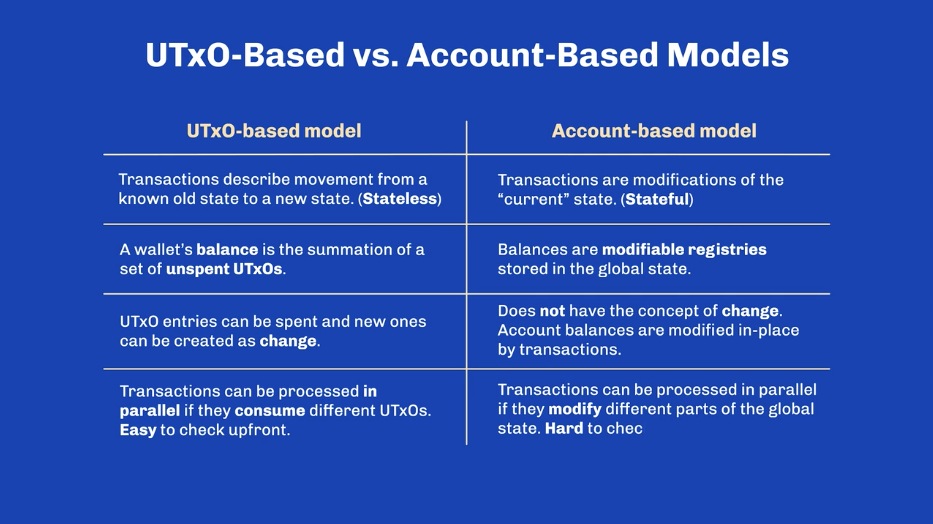As blockchain technology continues to evolve, different architectures are being adopted to improve scalability, security, and transaction handling. Two primary models currently dominate the landscape: the Account-Based Model, popularized by Ethereum, and the eUTxO Model, championed by Cardano. These models represent fundamentally different approaches to managing user balances, executing transactions, and supporting smart contracts.
In this article, we’ll explore the differences between these models, their advantages, and how they impact the functioning of their respective blockchains.
The Account-Based Model: Ethereum’s Approach
Ethereum, the second-largest blockchain by market capitalization, operates using an account-based model. This model is similar to the way traditional banking systems manage balances, where each user has an account that tracks their balance of assets like ETH (Ether).
How it Works:
- In Ethereum, users have a single account, and each transaction updates the balance in that account.
- The global state of the Ethereum network consists of a shared ledger where all accounts and their balances are stored.
- Each transaction either deducts from the sender’s account or adds to the recipient’s account, with the blockchain keeping track of changes to these balances.
Advantages of the Account-Based Model:
- Simplicity: The model is easy to understand because it works similarly to how traditional banks handle balances. For developers, this makes creating decentralized applications (dApps) more intuitive.
- Smart Contract Efficiency: Ethereum’s smart contracts use the same account system, making it easier to maintain state between contract executions.
- Global State: All transactions update a shared global state, allowing any smart contract or account to interact directly with others.
Challenges of the Account-Based Model:
- Concurrency Issues: Because all transactions update the global state, conflicts can arise when multiple transactions attempt to modify the same account simultaneously.
- Scalability Limits: The need to continuously update a single, shared global state can lead to bottlenecks in the network, especially as it grows.
- Complexity in Parallelism: Executing transactions in parallel is difficult because all transactions interact with the same global state, requiring careful coordination.
The eUTxO Model: Cardano’s Innovation
Cardano, another major blockchain, utilizes an extended UTXO (eUTxO) model, which is an evolution of Bitcoin’s original UTxO (Unspent Transaction Output) model. The eUTxO model introduces improvements that make it more suitable for handling complex smart contracts while maintaining Bitcoin’s transaction model.
How it Works:
- In Cardano, transactions consume unspent outputs from previous transactions, and in return, new outputs are created. Each output is a self-contained unit that specifies a certain amount of ADA (or another token) and the conditions under which it can be spent.
- The “extended” part of eUTxO adds support for smart contracts. Each output can include scripts (smart contracts) that define specific rules for spending the output.
Advantages of the eUTxO Model:
- Predictability: Since the state of the blockchain is not updated globally but rather as individual UTxOs are consumed and created, each transaction behaves in a more predictable manner.
- Parallelism: Multiple transactions can occur simultaneously without conflict because they do not modify the global state directly. This enables better parallel processing, improving scalability.
- Smart Contract Flexibility: The eUTxO model supports more complex transaction logic by embedding rules into UTxOs, providing enhanced security and flexibility for smart contracts.
- Security: The individual and discrete nature of UTxOs makes transaction validation simpler and less prone to errors or attacks compared to the account-based model.
Challenges of the eUTxO Model:
- Complexity for Developers: While the eUTxO model offers flexibility, it can be more challenging for developers to design and implement smart contracts compared to the more intuitive account-based model.
- Managing UTxOs: Users need to manage UTxOs carefully to avoid fragmentation, which can lead to inefficiencies when making large or complex transactions.
A Comparative Analysis

| Feature | Account-Based Model (Ethereum) | eUTxO Model (Cardano) |
|---|---|---|
| State Management | Global state shared by all accounts | Individual UTxOs tracked separately |
| Transaction Execution | Direct updates to balances | Consumes and creates UTxOs |
| Concurrency | Limited due to shared state | Enhanced through independent UTxOs |
| Smart Contract Support | Integrated with the account system | UTxOs can carry complex contract logic |
| Scalability | Slower due to global state updates | Faster, allows for parallel execution |
| Security | Less predictable; global state is prone to conflicts | More secure; each UTxO is independent |
Real-World Implications
The choice between the account-based and eUTxO models has significant implications for the networks that adopt them, as well as the developers and users who build on them.
- Ethereum’s Account-Based Model: This model has been instrumental in making Ethereum a popular platform for decentralized applications, DeFi, and NFTs. However, the limitations in scalability and concurrency are areas of concern as Ethereum grows.
- Cardano’s eUTxO Model: While still relatively new, the eUTxO model holds promise for future scalability and security. Its ability to handle parallel transactions without conflicts positions it as a solution for future blockchain growth. However, developer adoption is key to realizing its full potential.
Conclusion
Both the account-based model of Ethereum and the eUTxO model of Cardano represent different approaches to solving the challenges of blockchain scaling, security, and transaction processing. The account-based model is simpler and more familiar to developers, but it faces concurrency and scalability issues. The eUTxO model, on the other hand, offers more flexibility, security, and the potential for higher throughput but comes with additional complexity for developers.
As blockchain technology continues to mature, both models are likely to coexist, serving different use cases depending on the needs of developers and users. Understanding the fundamental differences between them is crucial for anyone looking to build or invest in blockchain platforms.


Leave a Reply